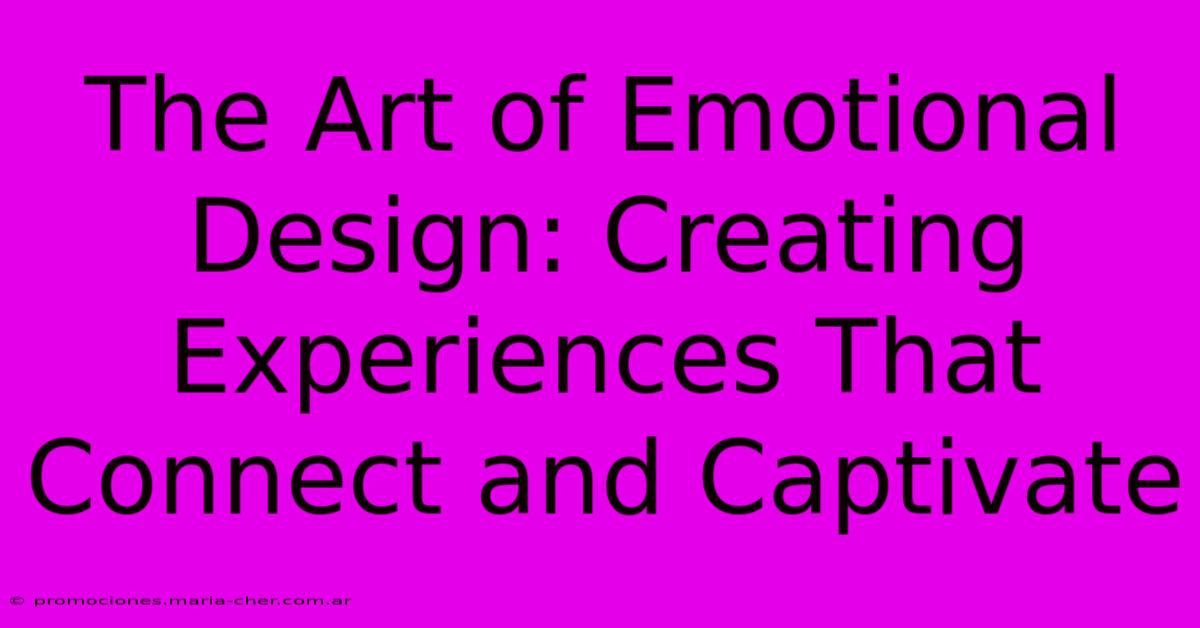The Art Of Emotional Design: Creating Experiences That Connect And Captivate

Table of Contents
The Art of Emotional Design: Creating Experiences That Connect and Captivate
In today's competitive landscape, simply creating a functional product or service isn't enough. To truly resonate with your audience and build lasting loyalty, you need to understand and master the art of emotional design. This isn't about superficial aesthetics; it's about crafting experiences that evoke genuine feelings and forge a deeper connection between your brand and your users. This article delves into the core principles of emotional design, exploring how to create products and services that not only meet functional needs but also captivate the hearts and minds of your customers.
Understanding the Trifecta of Emotional Design
Donald Norman, a pioneer in the field, outlines three key aspects of emotional design: visceral, behavioral, and reflective. Understanding this trifecta is crucial for creating truly impactful experiences.
1. Visceral Design: The Instantaneous Reaction
This is the immediate, gut-level response to a product or service. It's the first impression, driven by aesthetics, sensory experiences, and initial perceptions. Think of the sleek design of a high-end car, the satisfying click of a well-engineered pen, or the appealing aroma of freshly baked bread. Visceral design is about creating an immediate positive feeling that grabs attention and sets the stage for a more profound connection.
Key elements of visceral design:
- Aesthetics: Visually appealing design, color palettes, and typography.
- Sensory experiences: Tactile sensations, sounds, and smells.
- Intuitive usability: Easy to understand and interact with at first glance.
2. Behavioral Design: The Functionality Factor
While visceral design focuses on the initial impact, behavioral design centers on the usability and functionality of your product or service. It's about how easy and enjoyable it is to use, how well it fulfills its intended purpose, and how it makes users feel while they are using it. A seamless user experience, clear instructions, and a rewarding interaction all contribute to positive behavioral responses.
Key elements of behavioral design:
- Usability: Ease of use, clear instructions, intuitive navigation.
- Functionality: The product or service effectively meets the user's needs.
- Efficiency: Users can accomplish tasks quickly and easily.
- Feedback: Clear and timely feedback to user actions.
3. Reflective Design: The Long-Term Connection
This is the deeper, more conscious level of emotional engagement. It's about the overall experience, the memories created, and the lasting impact your product or service has on the user. Reflective design considers the user's personal values, their aspirations, and the overall meaning they derive from their interaction. This is where brand loyalty and emotional connection truly take root.
Key elements of reflective design:
- Personalization: Tailoring the experience to the individual user.
- Brand storytelling: Creating a narrative that resonates with users' values.
- Emotional resonance: Evoking feelings of joy, satisfaction, trust, or nostalgia.
- Social impact: Highlighting the positive impact of the product or service.
Applying Emotional Design Principles
Creating emotionally engaging experiences requires a holistic approach. Here are some practical steps:
- Understand your audience: Conduct thorough user research to understand their needs, values, and emotional drivers.
- Define your brand personality: Develop a clear brand identity that reflects your desired emotional connection with users.
- Prioritize user experience (UX): Ensure your product or service is intuitive, easy to use, and enjoyable.
- Incorporate storytelling: Use narratives and visuals to connect with users on an emotional level.
- Seek feedback and iterate: Continuously test and refine your design based on user feedback.
The Power of Emotional Connection
By mastering the art of emotional design, you can transform your products and services from mere functional tools into engaging experiences that foster loyalty and build a thriving community around your brand. This isn't just about selling a product; it's about creating meaningful connections and leaving a lasting positive impact on the lives of your users. The result? A stronger brand, increased customer satisfaction, and ultimately, greater success. So, embrace the power of emotion, and watch your brand flourish.

Thank you for visiting our website wich cover about The Art Of Emotional Design: Creating Experiences That Connect And Captivate. We hope the information provided has been useful to you. Feel free to contact us if you have any questions or need further assistance. See you next time and dont miss to bookmark.
Featured Posts
-
Create An Unforgettable Brides Bouquet Step By Step Guide To Floral Magic
Feb 08, 2025
-
The Seasons Delight Lily Of The Valley Bouquets At Prices You Wont Believe
Feb 08, 2025
-
Unveiling The Secrets Of Breathtaking Bulk Dried Babys Breath A Floral Wonderland
Feb 08, 2025
-
The Art Of Shadow And Light Mastering Frame Design For Black And White Excellence
Feb 08, 2025
-
Hot Pink Floral Extravaganza The Ultimate Inspiration For Breathtaking Wedding Bouquets
Feb 08, 2025
